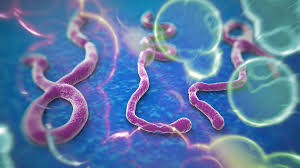20 Things you should know about the Ebola Virus Disease

20 Things you should know about the Ebola virus
1. Ebola virus disease (EVD), formerly known as Ebola haemorrhagic fever, is a severe, often fatal illness in humans.
2. EVD outbreaks have a case fatality rate of up to 90%.
3. EVD outbreaks occur primarily in remote villages in Central and West Africa, near tropical rainforests.
4. The virus is transmitted to people from wild animals and spreads in the human population through human-to-human transmission.
5. Fruit bats of the Pteropodidae family are considered to be the natural host of the Ebola virus.
6. Severely ill patients require intensive supportive care. No licensed specific treatment or vaccine is available for use in people or animals.
7. Ebola first appeared in 1976 in 2 simultaneous outbreaks, in Nzara, Sudan, and in Yambuku, Democratic Republic of Congo
8. Ebola is introduced into the human population through close contact with the blood, secretions, organs or other bodily fluids of infected animals.
9. In Africa, infection has been documented through the handling of infected chimpanzees, gorillas, fruit bats, monkeys, forest antelope and porcupines found ill or dead or in the rainforest.
10. Ebola then spreads in the community through human-to-human transmission, with infection resulting from direct contact (through broken skin or mucous membranes) with the blood, secretions, organs or other bodily fluids of infected people, and indirect contact with environments contaminated with such fluids.
11. Burial ceremonies in which mourners have direct contact with the body of the deceased person can also play a role in the transmission of Ebola.
12. Men who have recovered from the disease can still transmit the virus through their semen for up to 7 weeks after recovery from illness.
13. Ebola is a severe acute viral illness often characterized by the sudden onset of fever, intense weakness, muscle pain, headache and sore throat. This is followed by vomiting, diarrhoea, rash, impaired kidney and liver function, and in some cases, both internal and external bleeding.
14. The incubation period, that is, the time interval from infection with the virus to onset of symptoms, is 2 to 21 days.
15. Other diseases that should be ruled out before a diagnosis of EVD can be made include: malaria, typhoid fever, shigellosis, cholera, leptospirosis, plague, rickettsiosis, relapsing fever, meningitis, hepatitis and other viral haemorrhagic fevers.
16. No licensed vaccine for Ebola is available. Several vaccines are being tested, but none are available for clinical use.
17. In Africa, fruit bats, particularly species of the genera Hypsignathus monstrosus, Epomops franqueti and Myonycteris torquata, are considered possible natural hosts for Ebola virus.
18. Human-to-human transmission of the Ebola virus is primarily associated with direct or indirect contact with blood and body fluids.
19. It is not always possible to identify patients with EBV early because initial symptoms may be non-specific. For this reason, it is important that health-care workers apply standard precautions consistently with all patients – regardless of their diagnosis – in all work practices at all times. These include basic hand hygiene, respiratory hygiene, the use of personal protective equipment (according to the risk of splashes or other contact with infected materials), safe injection practices and safe burial practices.
20. Standard precautions are recommended in the care and treatment of all patients regardless of their perceived or confirmed infectious status. They include the basic level of infection control—hand hygiene, use of personal protective equipment to avoid direct contact with blood and body fluids, prevention of needle stick and injuries from other sharp instruments, and a set of environmental controls.





